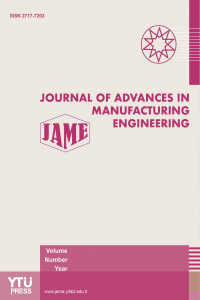Investigation of Chip Breaker and Its Effect in Turning Operations
Investigation of Chip Breaker and Its Effect in Turning Operations
Chip Breaker Chip Control, chip,
___
- [1] Jawahir, I.S. & Fang, X.D. (1995). A Knowledge-Based Approach for Designing Effective Grooved Chip Breakers - 2D and 3D Chip Flow, Chip Curl and Chip Breaking. Int J Adv Manuf Technol., 10, 225–239.
- [2] Lotfi, M., Farid A,. Soleimanimehr, H., (2015). The effect of chip breaker geometry on chip shape, bending moment, and cutting force: FE analysis and experimental study. Int J Adv Manuf Technol., 78, 917–925.
- [3] Shamoto, E., Aoki, T., Sencer, B., Suzuki, N., Hino, R., Koide, T. (2011). Control of chip flow with guide grooves for continuous chip disposal and chip-pulling turning. CIRP Annals, 60(1), 125-128.
- [4] Aoki, T., Sencer, B., Shamoto, E., Suzuki, N., Koide, T. (2016). Development of a high-performance chip-guiding turning process—tool design and chip flow control. Int J Adv Manuf Technol 85, 791–805.
- [5] Güllü, A., Şener, K. (2008). Dynamic Chip Breaker Design for Inconel 718 Using Positive Angle Tool Holder. Materials and Manufacturing Processes, 23(8), 852-857.
- [6] Choi, J., Lee, S. (2001). Efficient Chip Breaker Design by Predicting the Chip Breaking Performance, Int J Adv Manuf Technol 17, 489–497.
- [7] Pavani, P.N.L., Prasad, C.L.V.R.S.V., Ramji, K. (2017). Experimental Study & Optimization of Machining Parameters in Turning of AISI 1040 Steel with Micro-grooved WC Cutting Tools. Engineering Journal, 21(4), 155-169.
- [8] Kim, H.G., Sim, J.H., Kweon, H.J. (2009). Performance evaluation of chip breaker utilizing neural network. Journal of Materials Processing Technology, 209(2), 647-656.
- [9] D’Acunto, A., Coz, G.L., Moufki, A., Dudzinski, D. (2017). Effect of cutting edge geometry on chip flow direction – analytical modelling and experimental validation. Procedia CIRP, 58, 353-357. [10] Chen, D. C., You, C. S., Kao, S. H. (2016). Finite element analysis of chip breaker geometry in turning process, Advances in Mechanical Engineering 8(7), 1-10.
- [11] Dautzenberg, J.H., Jaspers, S.P.F.C., Taminiau, D.A. (1999). The Workpiece Material in Machining. Int J Adv Manuf Technol 15, 383–386.
- [12] Gurbuz, H. Kurt, A., Çiftçi, İ., Şeker, U. (2011). The Influence of Chip Breaker Geometry on Tool Stresses in Turning. Strojniski Vestnik, 57(2), 91-99. [13] Siqueira, B., Freitas, S.A., Pereira, R.B.D., Lauro, C.H.L., Brandao, L.C. (2019). Influence of chip breaker and helix angle on cutting efforts in the internal threading process. Int J Adv Manuf Technol 102, 1537–1546.
- [14] Nath, C., Kurfess, T. (2016). Obstruction-Type Chip Breakers for Controllable Chips and Improved Cooling/Lubrication during Drilling – A Feasibility Study. Procedia Manufacturing, 5, 375-385.
- [15] Liao, T., Jiang, F., Guo, B., Wang, F. (2017). Optimization and influence of the geometrical parameters of chip breaker for finishing machining of Fe-Cr-Ni stainless steel. Int J Adv Manuf Technol 93, 3663– 3675.
- [16] Pacella, M. (2019). A new low-feed chip breaking tool and its effect on chip morphology. Int J Adv Manuf Technol, 104, 1145–1157.
- [17] Yılmaz, B., Karabulut, Ş., Güllü, A. (2018). Performance analysis of new external chip breaker for efficient machining of Inconel 718 and optimization of the cutting parameters. Journal of Manufacturing Processes, 32, 553-563.
- [18] Degenhardth J. A., Devor, R.E., Kapoor, S.G. (2005). Generalized groove-type chip breaker effects on drilling for different drill diameters and flute shapes. International Journal of Machine Tools and Manufacture, 45(14), 1588-1597.
- [19] Joch, R., Pilc, J., Danis I., Drbul M., Krajcoviech S. (2019). Analysis of surface roughness in turning process using rotating tool with chip breaker for specific shapes of automotive transmission shafts, Transportation Research Procedia, 40, 295-301.
- [20] Sahu, S.K., Ozdoganlar, O.B., Devor, R.E., Kapoor, S.G. (2003). Effect of groove-type chip breakers on twist drill performance, International Journal of Machine Tools and Manufacture, 43(6), 617-627.
- [21] Mesquita, R.M.D., Soares, F.A.M., Marques, M.J.M.B. (1996). An Experimaental Study of The Effect of Cutting Speed On Chip Breaking. Journal of Materials Processing Technology, 56(1–4), 313–320.
- [22] Zlamal, T., Malotova, S., Szotkowski, T., Cep, R., Marinescu, I. D. (2019). The geometry of grooving tool and its influence on dynamic load, Transportation Research Procedia 40:602-609.
- [23] Miyazawa, H., Takeuchi S., Miyake, S., Murakawa, M. (1996). Sintered diamond cutting inserts with chip breaker prepared by laser technique. Surface and Coatings Technology, 86-87 (2), 797-802.
- [24] Jawahir, I.S., Ghosh, R., Fang, X.D., Li, P.X. (1995). An investigation of the effects of chip flow on tool-wear in machining with complex grooved tools. Wear, 184(2), 145-154.
- [25] Arsecularatne, J.A. (2004). Prediction of tool life for restricted contact and grooved tools based on equivalent feed. International Journal of Machine Tools and Manufacture, 44(12), 1271-1282.
- ISSN: 2717-7203
- Başlangıç: 2020
- Yayıncı: Yıldız Teknik Üniversitesi
Analyzing Optimum Process Parameters in Laser Cutting of EN10025-2 Steel Plate
Influence Structures of The Machine Tools on Roughness in Turning
Nabil KRİBES, Ouelaa NOUREDINE, Yallesse Med ATHMANE, Mabrouki TAREK
Experimental, Mechanical Characterizations of Friction Welding of Steel and Aluminium Joints
Abderrazak ALLALI, Mouloud AISSANI, Nadir MESRATI, Boubaker OTHMANI, Mihoub MEDKOUR, Ishaak BOUKHADOUNI
Research of Treatment Process of Conical Holes by Diamond Honing
Investigation of Chip Breaker and Its Effect in Turning Operations
